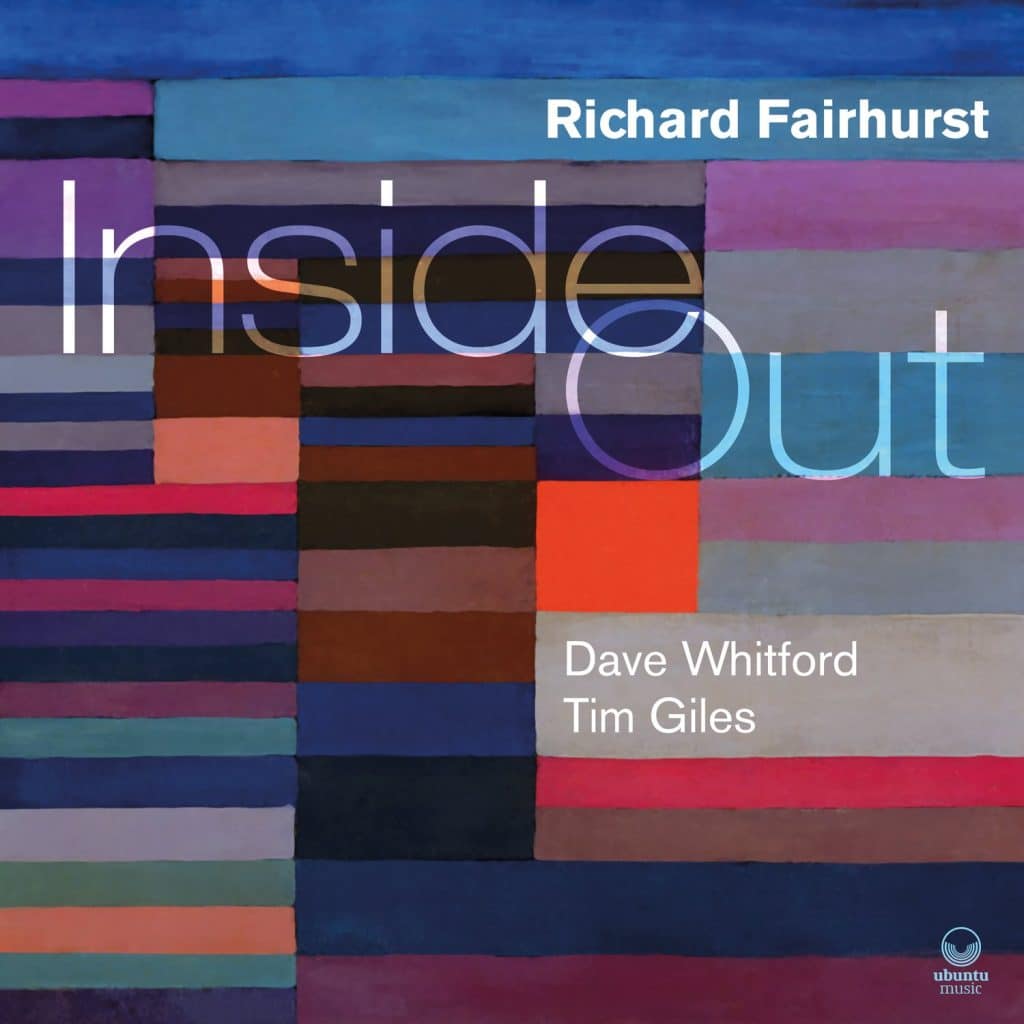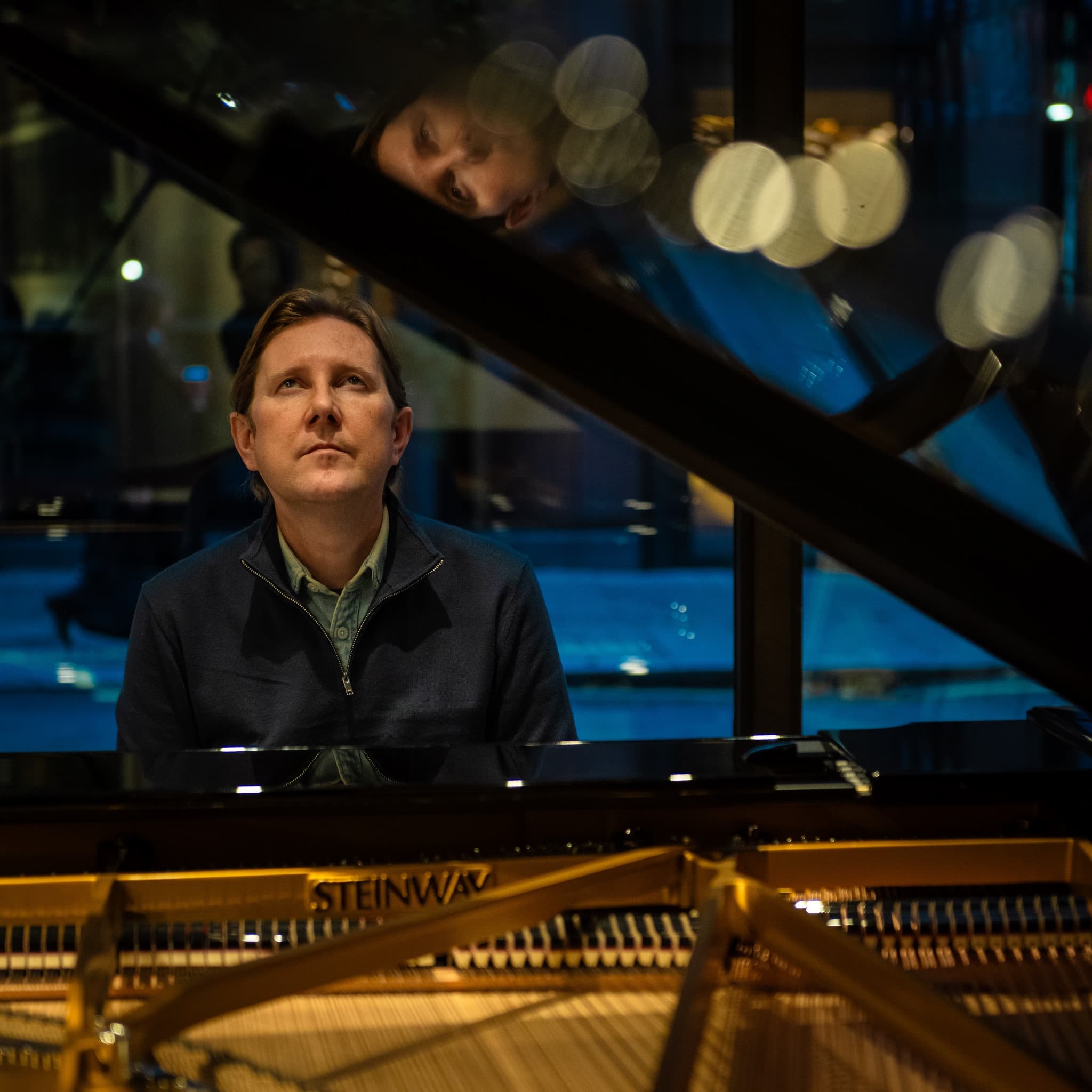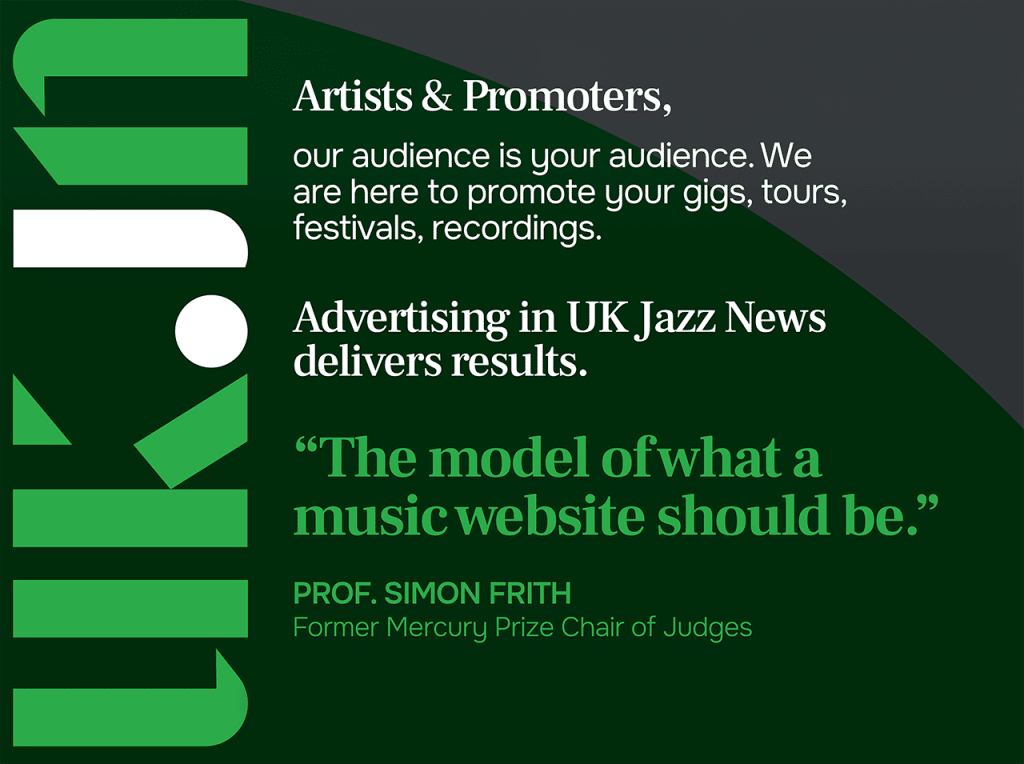“A really nice, cohesive feeling; Dave [Whitford] and Tim [Giles] are a great rhythm section,” says pianist Richard Fairhurst. Fairhurst’s new trio album ‘Inside Out’ is released by Ubuntu Music on 14 June. The trio tours the UK from June, with an album launch at London’s Vortex Jazz Club on 11 June. Feature by John Fordham.
If you’re lucky enough to develop an instinctive understanding with musical partners that evolves over time, then that’s something special,’ Richard Fairhurst says. The award-winning British pianist is musing on the rich jazz tradition of the classic piano trio, to which he’s been a significant contributor for years, and never more so than with this month’s release ‘Inside Out’, made with long-time friends and colleagues Dave Whitford on bass, and Tim Giles on drums.
He’s well aware that, as he says: ‘piano trios have been a common format in jazz for decades. There seem to be as many around today as there were half a century ago, and nobody starting one wants to sound like anyone else if it’s possible. But there’s so much space for interplay in a small improvising ensemble, so many different directions for the music to go, that there are plenty of ways to find your own path. The three of us in this trio feel the same way about music, it’s about the band connection, the space and feeling the moment.’
Fairhurst was a mid-teens starter on piano but his precocious arrival on the jazz stage came only five years later – when he recorded an acclaimed debut album in 1995 at only 19 with Iain Ballamy on saxes, and made it to the final of the Montreux Jazz Festival’s prestigious Solo Piano competition a year later. He became a Steinway artist in 1998, won a BBC Jazz Award in 2004 for his sextet compositions on ‘Standing Tall’, played the Proms in 2009 with adventurous trumpeter Tom Arthurs, and released his first trio album – ‘Triptych’ – in 2010. Sublime piano duos followed in the next decade, with his teacher, mentor and friend, the late great John Taylor – but though Fairhurst’s diverse adventures have embraced idiosyncratic postbop (with a few Django Bates and Iain Ballamy nuances early on), original composition for small and large ensembles, and an improvisational eloquence running from free-improv to high-energy avant-swing, a couple of midlife twists of fate brought him back to the trio and its openness to spontaneous rapport.
‘I was diagnosed with epilepsy around 2016, completely out of the blue,’ Fairhurst reveals. ‘It’s been totally under control with medication for six or seven years now, but that year was very strange, and I ended up in hospital for a bit. Epilepsy is difficult, because you’re not aware when you have a seizure, and when you come round you can be completely dazed for several hours before everything comes back into focus. It’s much harder for the people around you, and luckily it didn’t affect anything to do with being able to play the piano. But the whole experience made me reflect on music, on everything, and all I could think of wanting to do was to get out there and play again.’
Recovering by 2018, Fairhurst moved fast to assemble the ideal live band he had imagined, with bassist Dave Whitford and drummer Tim Giles. ‘I grew up listening to jazz with Tim, and we played together when he was 13 and I was 18, with Iain Ballamy at Ronnie Scott’s. There’s such a trust there with him after 32 years, I’m immediately comfortable playing with him and vice versa. So from 2018, the three of us went out playing some John Taylor tunes, some Carla Bley, a few standards, pieces of mine. It felt good, so I booked a gig at the Vortex and felt I should get some new music together for it. It wasn’t a mixture I would normally play, but it sparked immediately with us and the audience, and felt great. A really nice, cohesive feeling, and Dave and Tim are a great rhythm section. So we did that gig and I remember coming away from it on a real high. From there I booked as many gigs as I could, and we managed to do quite a few – until Covid arrived!’
That second hiatus in Richard Fairhurst’s performing life brought with it more time for reflection, practice, and composition – but uppermost in his mind was how quickly he and his partners could get back to capturing on disk the vivacity the trio had been radiating before the pandemic’s drawbridge closed. On earlier recordings, the pianist had figured out a tracklist close to the release’s final outcome, but the ingredients this group had come to mix whenever they got together – the leader’s originals, pieces by Carla Bley, and free improvisations – presented Fairhurst with some editing challenges after they had finally got to play for two days at north London’s Livingston Studios in late 2022.
‘Our music had evolved so fast in that short period between the band’s formation and the pandemic,’ Fairhurst says. ‘By the time of the lockdown, I couldn’t wait to make an album to show where we were at with the music. When we did get to the studio, we recorded far more music than we needed, we had a session at the end of each day where we recorded a number of improvised pieces – ten different pieces in all. It took a long time for me to structure the tracklist for the album afterwards, finding ways to fit the improvised pieces in alongside the composed material so the album felt totally cohesive. I made endless lists, cutting things out, putting things back in, and in the end the album was quite different from what I’d set out to make – but in a good way!’
The composer eventually settled on five of his own originals, two rhythmically zigzagging, improv-inviting pieces by Carla Bley – ‘Vashkar’ and ‘King Korn’, both recorded in the early 1960s by her first husband, pioneering piano original Paul Bley. Grouped between four interludes of group improv like ‘Eclipse’, with its delicate treble trickles nudged by Whitford’s bass figures, the title track with its under-the-lid strings sounds and soft piano-woodwork percussion, and ‘Sunset’ with its bell chimes, bass prods, and sparing keyboard whispers come composed pieces that highlighted Fairhurst’s idiomatic adaptability.
The opening ‘Ash Catcher’ roams slowly toward swing through surges of melody against cymbal swishes and quiet drum tattoos, ‘Uplift’ has a free-rhythmic building and receding sway before a Bill Evans-like medium groove picks up, and the quick, wriggling figures against drum patterns that introduce ‘Figments’ give way to a snappy funk groove. ‘Flyby’ is hustling Ornettish avant-swing, while the awed and tranquil ‘Open Book’ is a reminder that Fairhurst last recorded this haunting reverie as a duo with John Taylor, shortly before that modest piano genius’s sudden death in 2015. It’s an eclectic repertoire as it is, but Fairhurst stretched it considerably further – particularly rhythmically – by including the then twentysomething Carla Bley’s early calling-cards, ‘Vashkar’ and ‘King Korn’.

In our phone interview, Fairhurst and I discover that we both first got to hear those tantalising tunes – though we must have heard them 20 years apart – by admiring their presence on extraordinary 1960s Paul Bley albums like ‘Footloose’ (a classic session that Keith Jarrett said he had listened to thousands of times), and ‘Turning Point’.
‘Carla’s writing is quirky and unusual, her pieces go in unexpected directions, they allow a lot of room for different improvising routes,’ Fairhurst says. ‘The melody of “Vashkar” is beautiful, yet so simple, sitting fairly abstractly in its time signature. Paul Bley plays the melody of “King Korn” quite deconstructed, and out of time, so I thought I’d play it in time which sounded cool. Carla wrote it using standard-song rhythm changes for the solo section, but we play that in an open way without chord changes, which for me works best with that tune. These pieces can be approached in many different ways within the trio and are always shifting around.’
The jazz piano trio was basically a bigger band’s rhythm section on a few nights off until the bebop era of the 1940s – but though there were influential examples led by Bud Powell, Thelonious Monk, and Ahmad Jamal in the postwar world, it was what Miles Davis described as the ‘quiet fire’ of Bill Evans from the late 1950s on that spurred a seismic change still being felt today. With shortlived bass virtuoso Scott La Faro and world-musical drummer Paul Motian, Evans took the art of in-the-moment collective improvisation to a new level.
‘That’s how today’s piano trio sound has grown,’ Fairhurst says. ‘From Bill Evans and Paul Bley in the ’60s and onwards, to Keith Jarrett, and Brad Mehldau – with all the development of left-hand countermelody Mehldau initiated – they’ve all contributed so much to making the trio sound evolve. For my part, of course I would include JT (John Taylor) in that list, who’s always in my head – such an amazing human being too, so generous, funny and so easy to get on with, and whose ideas always have a footprint on my work, particularly in terms of harmony. And from the number of young players emerging now, the process is obviously still going on. When I pick my charts up, and go and meet Tim and Dave to play – musicians that I love and I’m friends with – we always enjoy getting together and having a good time making this music happen. In terms of the trio tradition, I’m certain it’s always going to be around.’
Richard Fairhurst’s ‘Inside Out’ is released by Ubuntu Music on 14 June. The trio tours the UK from June 8, with an album launch at London’s Vortex Jazz Club on June 11.


